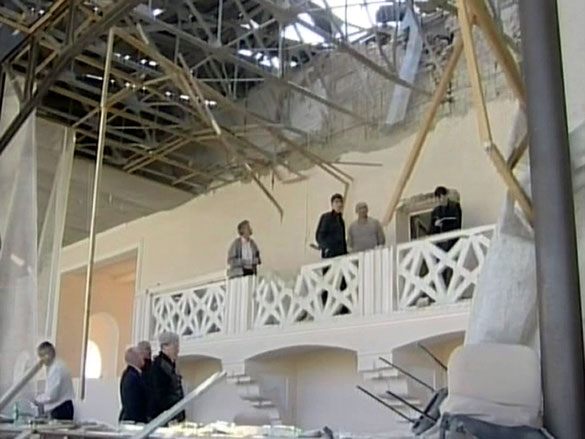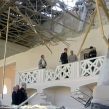
Nalchik Bomb Attack Endangers the Stability of Kabardino-Balkaria
Publication: Eurasia Daily Monitor Volume: 7 Issue: 88
By:

On May 1, an explosion shook Nalchik, the capital of Kabardino-Balkaria. A home-made explosive device estimated at equaling 3-5 kilograms of TNT went off at the time as current and former republican top officials were entering a tribune set aside for them at the Nalchik hippodrome. One elderly WWII veteran was reportedly killed in the attack while the republic’s former Interior Minister, Khachim Shogenov, and current Culture Minister, Ruslan Firov, were wounded along with 27 other people. The President of Kabardino-Balkaria, Arsen Kanokov, was also expected to attend the event, but changed his work schedule at the last minute (www.gazeta.ru, May 4).
Investigators stated that the attackers may have targeted Kanokov or Shogenov. The militant underground insurgency in Kabardino-Balkaria was declared the primary suspect in the bombing (Kommersant, May 4). Shogenov was known for his brutal practices in dealing with not-officially-approved Islamic youth groups while he was interior minister. Many observers believed that the intolerance and cruelty police displayed toward Islamic groups it did not control led to the mass revolt in October 2005. Over 100 people died in the armed uprising, most of those killed being among the rebels. Indirect evidence of this is that Shogenov was replaced for his “mistakes” soon after Kanokov was sworn in as the republic’s new president.
Sergei Markedonov, a noted Russian commentator on North Caucasus affairs, stated that the May 1 attack may have been two-pronged –aimed, on the one hand, at avenging police operations against the militant insurgency in the past year and, on the other hand, at generally destabilizing the situation in the republic (www.regnum.ru, May 3). Ivan Sukhov of the Moscow-based newspaper Vremya Novostei, who is a regular visitor to the North Caucasus, said in an interview that the attack may have had a political dimension, as President Kanokov was nearing the end of his first presidential term and his opponents may have been tempted to undermine his authority by destabilizing Kabardino-Balkaria (www.ekhokavkaza.com, May 4)
One of the prominent insurgent leaders in Kabardino-Balkaria, Musa Mukozhev, was reported to have been killed in a police special operation on May 11, 2009 after years of living underground. The police reported that Mukozhev’s car exploded in a shootout with the police, burning him and two of his accomplices alive (www.kavkaz-uzel.ru, May 11, 2009). Another leader of the insurgency, Anzor Astemirov, was killed on March 24, 2010 in a shootout in Nalchik (www.kavkaz-uzel.ru, March 24).
The Gazeta Yuga weekly, published in Nalchik, noted on April 29 that the methods of killing insurgents were strikingly similar in several cases. The paper gave the example of two other rebel suspects who were reportedly blown up in their own car on April 21 after police tried to stop them and a shootout ensued. This and several other incidents, including the killing of Musa Mukozhev, show that the security services in Kabardino-Balkaria still prefers to kill rebel suspects and avoid bringing formal charges against them in the courts. If it is proven that the rebels were behind the attack on the leadership of Kabardino-Balkaria at the Nalchik hippodrome on May 1, the security services’ methods may have brought about little good.
The Kabardino-Balkarian police announced a $100,000 reward for information about the perpetrators of the attack. Prime Minister, Vladimir Putin, allotted $24,000 for the family of the man killed in the attack and smaller sums for the wounded victims.
The Kavkazsky Uzel (Caucasian Knot) website, which focuses on events in the North Caucasus, noted that the attacks were mounting in Kabardino-Balkaria even prior to the latest explosion. On April 29, two policemen and two civilians were wounded in an explosion in Nalchik. On April 28, one policeman was killed and another was wounded when unknown assailers attacked a police car. On April 24, a police officer was wounded when his house outside Nalchik came under fire. The police had announced earlier that they believe the insurgency in Kabardino-Balkaria numbers about 50 people. They also reported that 67 policemen were killed in attacks in the republic during the past 15 years.
Apart from rebel attacks and clashes with police, several mass brawls have taken place in multiethnic Kabardino-Balkaria over the last several years. Although ethnic Kabardins comprise a clear majority of the republic’s population of 900,000 –55 percent– it has a small, but very active indigenous population of Balkars –12 percent– and a sizeable ethnic population –25 percent of whom are Russian/Cossacks (www.perepis2002.ru). One of the latest fistfights took place on April 7 in a mixed Kabardin-Cossack populated area of the republic’s Prokhladny district. Cossack leaders expressed concern for their young generation, which could leave the republic in the ever increasing numbers. Several mass fights between youths divided along ethnic lines also took place also in 2009 (www.kavkaz-uzel.ru, April 13).
On April 22, Moscow’s envoy to the North Caucasus, Aleksandr Khloponin, met the Cossack leaders in Kabardino-Balkaria and asked them why Russians are leaving the region. The Cossacks complained about high crime rates and their vulnerability, with “newcomers” from other places in Kabardino-Balkaria [ethnic Kabardins] attacking them, along with other problems, such as their lack of access to ploughed lands. Khloponin promised credits on favorable terms, but asked for detailed business-plans (Gazeta Yuga, April 29).
Political conflict, along with sharpening ethnic divisions, are contributing to the gradual destabilization of Kabardino-Balkaria, which may further complicate the security situation in the North Caucasus and jeopardize the 2014 Sochi Olympic games in the neighboring Krasnodar region.




